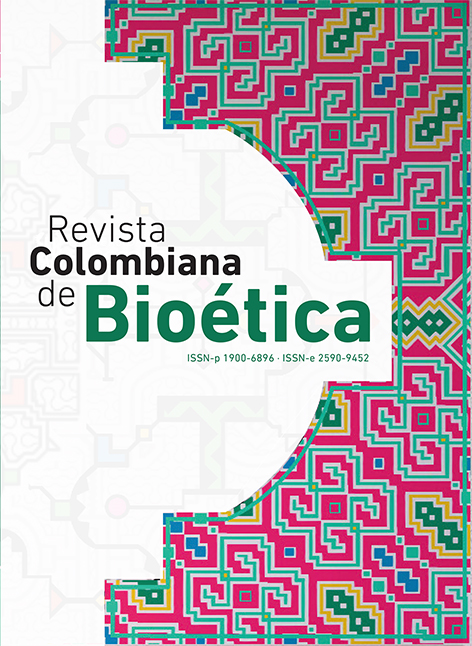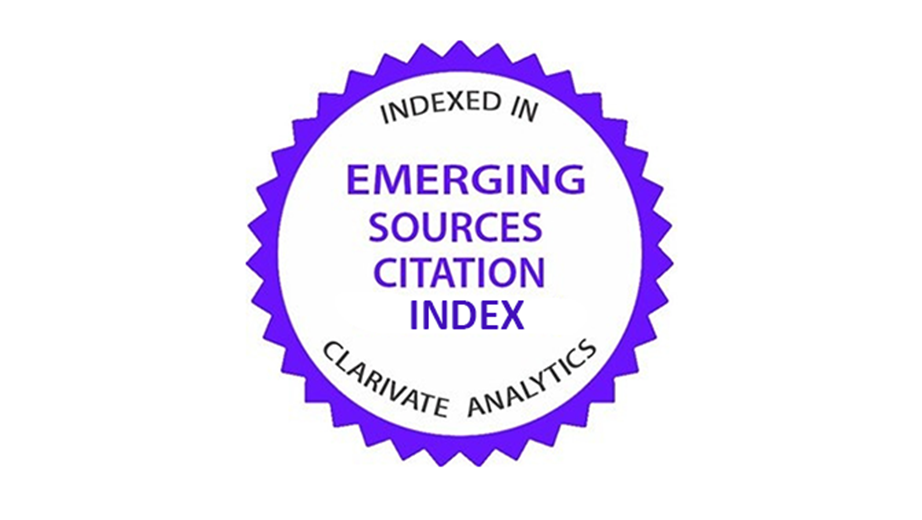Ethics in the university
an educational experience with the TV series Merlí
DOI:
https://doi.org/10.18270/rcb.v15i2.2947Keywords:
Ethical training, deontology, moral, audiovisual format, series, training experience, bioethicsAbstract
Purpose/Context. The purpose of this article is to investigate the university teaching of ethics in health sciences through a TV series. Training experiences in this area usually focus on future professional practice through brief clinical cases, leaving the educational field relegated.
Methodology/Approach. The methodology used is mixed. The REST tool for the evaluation of ethical sensitivity is taken as an antecedent from the detection of dilemmatic elements in an audiovisual and an experience of teaching innovation is carried out with a fragment of the TV series Merlí where a case of academic dishonesty is reported. The students had to define the dilemmatic situations of the fragment and articulate them with the university code of ethics. The study includes quantitative elements of detection of situations and ethical principles, and qualitative elements of content analysis.
Results/Findings. The results are, on the one hand, the identification of all the situations of the fragment, focusing more on the fact that they have teachers as protagonists, and also, those that imply an explicit transgression of the norms. Students can identify dilemmatic situations but find it more complex to link them to ethical principles.
Discussion/Conclusions/Contributions.The main contribution of the article is to note the relevance of the application and the reflection on ethics in the university environment, while highlighting the usefulness of cinema and television series in experiences of pedagogical innovation in ethics and bioethics.
Downloads
References
2. BAÑOS DIEZ, J.E., ARAMBURU BELTRÁN, J.F., y SENTÍ CLAPÉS, M. (2005). Biocinema: la experiencia de emplear películas comerciales con estudiantes de Biología. Revista Medicina y Cine, 1, pp. 42-46. Recuperado de: https://revistas.usal.es/index.php/medicina_y_cine/article/view/221/406
3. BAÑOS, J. E., y BOSCH, F. (2015). Using feature films as a teaching tool in medical schools. Educación médica 16(4), pp. 206-211. Recuperado de: https://www.sciencedirect.com/science/article/pii/S1575181315000200
4. BAÑOS, J.E., y PÉREZ, J. (2005). Cómo fomentar las competencias transversales en los estudios de Ciencias de la Salud: una propuesta de actividades. Educación Médica, 8(4), pp. 40-49. Recuperado de: http://scielo.isciii.es/scielo.php?script=sci_arttext&pid=S1575-18132005000500006
5. BARDIN, L. (1996). Análisis de contenido. Madrid: Akal.
6. BARRIGA, F., PÉREZ, M., y LARA, Y. (2016) Para enseñar ética profesional no basta con una asignatura: Los estudiantes de Psicología reportan incidentes críticos en aulas y escenarios reales. Revista Iberoamericana de educación superior, 7(18). ISNN 2007-28. Recuperado de: http://www.scielo.org.mx/scielo.php?script=sci_arttext&pid=S2007-28722016000100042
7. BARROSO TRISTÁN, J. M., y GONZÁLEZ MONTEAGUDO, J. (2018). Perspectivas de estudiantes universitarios sobre autoridad, ética e ideología docente en Brasil. Perfiles Educativos, 40 (161), pp. 69-86. Recuperado de: https://doi.org/10.22201/iisue.24486167e.2018.161.58518
8. BENASAYAG, A. (2017) La hipótesis de la cinefilia docente. El cine de ficción en la escuela media argentina. Revista Digital do LAV, 10(2), pp. 56-78. Brasil: Universidade Federal de Santa Maria. Recuperado de: https://periodicos.ufsm.br/revislav/article/download/27504/pdf
9. BOLÍVAR, A. (2005). El lugar de la ética profesional en la formación universitaria. Revista Mexicana de Investigación Educativa, 10(24), pp. 93-123. Recuperado de: https://www.redalyc.org/articulo.oa?id=14002406
10. BRABECK, M. M., ROGERS, L. A., SIRIN, S., HENDERSON, J., BENVENUTO, M., y WEAVER, M. (2000). Increasing Ethical Sensitivity to Racial and Gender intolerante in Schools: Development of the Racial Ethical Sensitivity Test. Ethics & Behavior, 10(2), pp. 119-137. Recuperado de: https://www.tandfonline.com/doi/abs/10.1207/S15327019EB1002_02
17. CAPELLO, G. (2017). Introducción: ¿Qué cuentan las historias de la tele? En G. Capello (Ed.) Ficciones cercanas: televisión, narración y espíritu de los tiempos (pp. 15-18). Perú, Universidad de Lima: Fondo Editorial.
18. CHAMBERS, T. S. (2001). The fiction of Bioethics: a précis. The American Journal of Bioethics, 1(1), pp. 40-43. Recuperado de: https://muse.jhu.edu/article/178886
19. COLINA VARGAS, A. M., y VARGAS DE CARRASQUERO, I. C. (2018). La ética del docente investigador y sus principios. Revista Científica Ecociencia, 4(5), pp. 1-19. Recuperado de: http://revistas.ecotec.edu.ec/index.php/ecociencia/article/view/50
20. CORTINA, A., y CONILL, J. (2000). El sentido de las profesiones. Navarra: Vervo Divino.
21. CRISOL, M., y ROMERO, M.A. (2014). Práctica docente versus ética docente. Hacia la mejora de la práctica docente a partir de la ética profesional. Journal for Educators, Teachers and Trainers, 5(2), pp. 23–35. Recuperado de: http://diposit.ub.edu/dspace/bitstream/2445/113790/1/LA%20ENSE%c3%91ANZA%20UNIVERSITARIA%20DE%20LA%20%c3%89TICA.pdf
22. CZARNY, M., FADEN, R., NOLAN, M., BODENSIEK, E., y SUGARMAN, J. (2008). Medical and nursing students; television viewing habits: potential implications for bioethics. The American Journal of Bioethics, 8(12), pp. 1-8. Recuperado de: https://doi.org/10.1080/15265160802559153
23. CZARNY, M., FADEN, R., y SUGARMAN, J. (2010) Bioethics and professionalism in popular television medical dramas. Journal of Medical Ethics, 36(4), pp. 203-206. Recuperado de: http://dx.doi.org/10.1136/jme.2009.033621
24. DARBYSHIRE, D., y BAKER, P. (2012). A systematic review and thematic analysis of cinema in medical education. Medical Humanities, 38, pp. 28-33. Recuperado de: https://doi.org/10.1136/medhum-2011-010026
25. DEL CASTILLO, S.D., y RODRÍGUEZ, A.T.N. (2018). La ética de la investigación científica y su inclusión en las ciencias de la salud. Acta Médica del Centro, 12(2), pp. 213-227. Recuperado de: https://www.medigraphic.com/pdfs/medicadelcentro/mec-2018/mec182n.pdf
26. GIRÓ MIRANDA, J. (2018). El cine en la formación inicial docente. Revista de Sociología de la Educación (RASE), 11 (3), pp. 464-473. Recuperado de: https://doi.org/10.7203/RASE.11.3.13073
27. GARCÍA-BORRÁS, F. J. (2009). Bienvenido Mister Cine a la enseñanza de las ciencias. Revista Eureka sobre Enseñanza y Divulgación de las Ciencias, 6(1), pp. 79-91. Recuperado de: https://revistas.uca.es/index.php/eureka/article/view/3724/3302
28. GÓMEZ, M., y MICHEL FARIÑA, J.J. (2012). Editorial: Series: una interpretación del síntoma. Ética y Cine Journal, 2 (2), pp. 9-10. Recuperado de: http://journal.eticaycine.org/Series-una-interpretacion-del-sintoma
29. GÓMEZ PONCE, A. (2018). Instintos en serie. Ética y Cine Journal, 8 (3), pp. 43-57. Recuperado de: http://journal.eticaycine.org/Instintos-en-serie
30. GONZÁLEZ BLASCO, P., PINHEIRO, R., ULLOA-RODRÍGUEZ, M.F., y ANGULO-CALDERÓN, N.M. (2009). El cine en la formación ética del médico: un recurso pedagógico que facilita el aprendizaje. Persona y Bioética, 13(2), pp. 114-127. Recuperado de: http://www.scielo.org.co/scielo.php?script=sci_arttext&pid=S0123-31222009000200002&lng=en&tlng=es
31. HANSEN, D. (2001). Explorando el corazón moral de la enseñanza. Barcelona: Idea Books.
32. HÉRNANDEZ GONZÁLEZ, M., GONZÁLEZ ORNELAS, V., y PÉREZ FERRA, M. (2016). El quehacer ético del profesorado de secundaria: un análisis a través de sus actitudes y su razonamiento. Estudio de caso en el contexto mexicano. Enseñanza & Teaching, 34(1), pp. 17-34. Recuperado de: https://revistas.usal.es/index.php/0212-5374/article/view/et20163411734/15154
33. HIRSCH, A. (2011), Dilemas, tensiones y contradicciones en la conducta ética de los profesores. Sinéctica, 37, pp. 109-124. Recuperado de: http://www.scielo.org.mx/pdf/sine/n37/n37a6.pdf
35. JACKSON, P., BOOSTROM, R., y HANSEN, D. (2003). La vida moral en la escuela. Buenos Aires: Amorrortu.
36. KIRKPATRICK, D.L., y KIRKPATRICK, J.D. (2006). Evaluating training programs: The four levels. Estados Unidos: Berrett-Koehler.
37. LAW, M., KWONG, W., FRIESEN, F., VEINOT, P., y NG, S. (2015). The current landscape of television and movies in medical education. Perspectives on Medical Education, 4(5), pp. 218-224. Recuperado de: https://doi.org/10.1007/s40037-015-0205-9
38. MARTÍN-ESPINOSA, N., PÍRIZ-CAMPOS, R., CARMONA-TORRES, J.M., y COBO-CUENCA, A.I. (2017). Cine y Dilemas Éticos: su uso en el aprendizaje basado en problemas. Book of abstracts CIVINEDU 2017: 1st International Virtual Conference on Educational Research and Innovation.
41. MATEUS, J.C. (2017). Las teleseries también educan. Una defensa de las ficciones televisivas como dispositivos de aprendizaje. En G. Cappello (ed.) Ficciones cercanas. Televisión, narración y espíritu de los tiempos (pp. 179-195). Universidad de Lima, Lima: Fondo Editorial.
42. MICHEL FARIÑA, J.J. (2001). La ética en movimiento. Cuaderno de Humanidades, 1(1), pp. 15-25.
43. MICHEL FARIÑA, J.J, SALOMONE, G., COSTA, G. L., RODRÍGUEZ, A., LUZZI, S., y PÉREZ FERRETI, F. (2008). Sensibilidad ética en el ámbito educativo: la adaptación al español del Racial and Ethical Sensitivity Test (REST) Memorias del XV Jornadas de Investigación y Cuarto Encuentro de Investigadores en Psicología del Mercosur. Facultad de Psicología, Universidad de Buenos Aires. Recuperado de: https://www.aacademica.org/000-032/41
44. MOLINA MONTOYA, N.P. (2016). Formación bioética en ciencias de la salud. Ciencia y Tecnología para la Salud Visual y Ocular, 14(1), pp. 117-32. Recuperado de: https://ciencia.lasalle.edu.co/svo/vol14/iss1/5/
45. NICOLÁS-GAVILÁN, M.T., GALBÁN-LOZANO, S.E., y ORTEGA BARBA, C.F. (2017). The Newsroom: uso de una serie de televisión para la formación ética de futuros profesionales de la información. El profesional de la información, 26(2). Recuperado de: https://recyt.fecyt.es/index.php/EPI/article/view/epi.2017.mar.14
46. OREFICE, C., PÉREZ, J., y BAÑOS, J.E. (2019). The presence of humanities in the curricula of medical students in Spain. Educación Médica, 20(2), pp. 79-86. Recuperado de: https://www.sciencedirect.com/science/article/pii/S1575181318300056
47. PÉREZ SÁNCHEZ, J. (2008). El uso de la película Despertares (1990) para evaluar aprendizajes en la licenciatura de Biología de la Universidad Pompeu Fabra. Diez años de experiencia. Revista Medicina y Cine, 5(1). Recuperado de: http://campus.usal.es/~revistamedicinacine/Vol_5/5.1/esp.5.1.htlm/despertares.htm
48. PÉREZ, J., ARAMBURU, J., BAÑOS, J.E., BOSCH, B., DÍEZ, J., FARRÉ, M., GIRVENT, M., SENTÍ, M. y VALVERDE, O. (2014) Uso del cine comercial como herramienta docente en estudios en ciencias de la salud: una experiencia multidisciplinar y colectiva. FEM: Revista de la Fundación Educación Médica, 17(3), pp. 131-135. Recuperado de: http://dx.doi.org/10.4321/S2014-98322014000300002
49. PETIT PÉREZ, F., y SOLBES MATARREDONA, J. (2014). El cine de ciencia ficción en la enseñanza de las ciencias en secundaria. Enseñanza de las ciencias, 33(1), pp. 267-268. Recuperado de: https://revistas.uca.es/index.php/eureka/article/view/2923/2628
50. PINTO BUSTAMANTE, B.J., y GÓMEZ CÓRDOBA, A.I. (2019). Conflictos, dilemas y paradojas: cine y bioética en el inicio de la vida. Rosario: Editorial Universidad de Rosario.
51. PULIDO CASTELBLANCO, D.P., PULECIO RIVERA, C.C., y PATIÑO CHAVES, O.I. (2019). Validación de una cartilla pedagógica para enseñar ética de manera crítica y reflexiva en psicología. Revista Colombiana de Bioética, 14 (2), pp. 34-51. Universidad del Bosque. Recuperado de: https://revistas.unbosque.edu.co/index.php/RCB/article/view/2562/2218
52. REST, J.R. (1979). Development in judging moral issues. Minneapolis: University of Minnesota Press.
53. SCOTTI, M., y ZELMANOVICH, P. (2018). Para abordar el malestar en las prácticas socioeducativas. A través del cine en diálogo con el psicoanálisis. Buenos Aires: Homo Sapiens.
54. SOLBAKK, J. H. (2014). Movements and Movies in Bioethics: The Use of Theatre and Cinema in Teaching Bioethics. En H. Ten Have (Ed). Bioethics Education in a Global Perspective (pp 203-221). New York: Springer
55. WEAVER, R., y WILSON, I. (2011). Australian medical students' perceptions of professionalism and ethics in medical television programs. BMC Medical Education, 11(1), 50. Recuperado de: https://doi.org/10.1186/1472-6920-11-50
56. WILLIAMS, D., RE, D., y OZAKINCI, G. (2014). Television viewing habits of preclinical UK medical undergraduates: further potential implications for bioethics. AJOB Empirical Bioethics, 5(2), pp. 55-67. Recuperado de: https://doi.org/10.1080/21507716.2013.826297
Downloads
Published
How to Cite
Issue
Section
License
Copyright (c) 2020 Revista Colombiana de Bioética

This work is licensed under a Creative Commons Attribution-NonCommercial-NoDerivatives 4.0 International License.

Esta obra está bajo licencia internacional Creative Commons Reconocimiento-NoComercial-SinObrasDerivadas 4.0.















